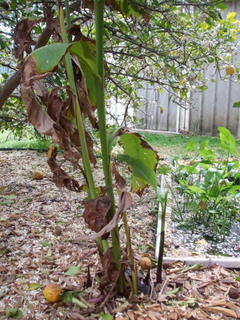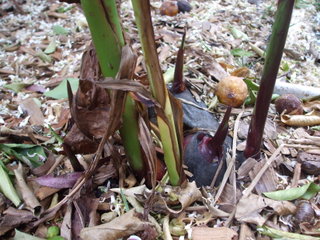We like Asian food in our house and consequently when I am cooking I tend to cook it quite a bit, so growing the ingredients makes sense for us. I became interested in water chestnuts a few years ago, after being given some tubers by a friend I decided to try and grow them. My first effort was in a concrete pot out the front of our house and for whatever reason, that year I got about three water chestnuts per pot, and pretty small and disappointing they were too. So the project went on hold.
I saw them for sale by mail order a few years later and thought I would try a different tack by growing them in a recycled bath tub in the back yard. They were also advertising a different water chestnut-like plant called Arrowhead (Sagittaria Latifolia) or Duck Potato, a north American edible tuber, so I got some of them too. The rush-like leaves of the water chestnuts, while interesting, are not particularly decorative but the arrow shaped leaves and white flowers of the Arrowhead are very decorative. The mature Arrowhead bulbs when harvested can also look a bit like an eyeball – very entertaining for visitors!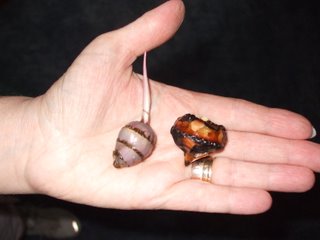
Our neighbours were remodelling their bathroom and getting rid of their enamelled steel bath, so after asking, I nipped it out of their skip bin and spirited it home to the back yard. My lovely partner is sustainable living knows my habit of putting things off so declared the next weekend that it had to go in the ground, NOW! So off I went shovel in hand and conned my son-in-law into helping me. We dug the appropriate sized hole and lowered the bath into it. We sited the bath in between the lemonade tree, the lemon tree and the mandarine tree with a northerly aspect so that it gets sun for most of the day but is shaded from the harsh afternoon summer sun.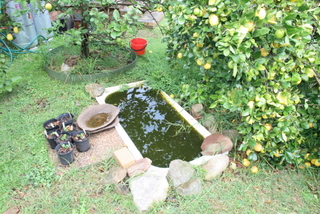
I plugged the drain hole with a standard drain plug and then put a layer of 12mm gravel over the bottom slope of the bath to give a firm base to place the pots on. I
was able to fill it with rainwater from one of the tanks on the back of the garage, so that it was then ready for habitation.
To plant the water chestnuts and arrowhead was the next task, so I got hold of six 200mm black plastic pots and to make sure of good water flow through them, punched a stack of holes in the sides of the pot using a 6mm hole punch and hammer. I then filled the pots with a conventional potting mix to about 10-15mm from the up of the put, placing a water chestnut or arrow tuber ot two in each pot, about half way down. Each pot was then topped off with a layer of small round gravel to retain everything in the pot as I put it in the water.

I placed all of the pots into the water garden slowly to allow the water to filter in and this worked pretty well, each pot wound up about 25mm below the surface of the water. Since the weather was warming up I soon noticed mosquito wrigglers making an appearance so the addition of half a dozen goldfish meant no more wrigglers, lots of entertainment and fertilizer for the plants.
Both types of plants have grown well in the water garden over the last few years and maintenance has been minimal, mostly consisting of replacing the water lost by evaporation and transpiration form the water plants every week of two in summer. As the days get cool the plants die down and it is time to harvest although in later summer and autumn you can get decent size tubers by just feeling around the bottom of the pond.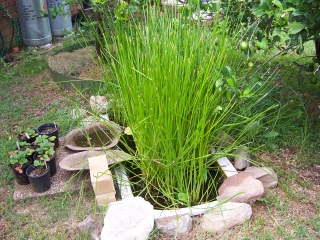
Harvesting consists of removing the pots from the water garden and tipping them out and sorting through the cold, wet and slightly smelly potting mix (this is one of my favourite jobs!) to remove the tubers and gravel for use next year. Last year i pulled out 5 kilograms worth of tubers so I must be doing something right! Due to the nature of how they grow, you will also find escapee tubers in the gravel in the bottom of the water garden, so don’t forget to look there too.
I keep a dozen or so of the best and biggest tubers for replanting and the rest get washed off and placed in clean water in the fridge, change the water every few days and use them up as you can. They don’t look all white and naked like they do when you get them out of the can; you have to peel them with a potato peeler, we generally slice them and put them in stir fries or put them in dishes such as san choi bow for their crisp and crunchy texture.
To replant for next year, just replace the potting mix and place a tuber or two in each pot, re-apply the gravel and sink the pots back in the water garden. In spring, when the weather starts to warm up, they will sprout again from the pots and start a new year’s supply for you.
Update 2012
The lowest point of the bath is the south western corner and the bath is designed to drain to that point, the idea being that there are times when the bath needs a bit of a flush out such as after a couple of lemons or mandarins have fallen into it. You tend to get a (citrus) oily film on top and I am not sure what the fish think of it so once the fruit is removed, a bit of a flush out goes a long way.
Anyway, because all the water (and of course some of the nutrients) drain to this corner I thought it would be worthwhile planting something that could convert these nutrients into food. When I was doing my Permaculture Design course last year we went to a property that allowed me to get hold of a piece of arrowroot from one of their plants and arrowroot loves waterlogged, boggy soils. I scratched away at the ground and then planted my bit of arrowroot, unsure of how it would do.
At the end of last winter it shot up a couple of canes over two metres high, so it seems reasonable happy, but even so I was not sure how the frost would affect it. We have now come out of its second winter here and while some of the leaves got scorched, even under the canopy of the lemon and lemonade trees, it is proceeding to send out lots of new spikes heralding a great growing year.
I can recommend including arrowroot in your plantings around your productive water garden, they add even more visual interest and another great food for you to experiment with, assuming you haven’t tried it already.
NOTE: If you have read this article previous to November 2012, your memory may be that I referred to the plant above as taro. After some research I have come to the conclusion that it is in fact arrowroot. My apologies to any of you that were lead astray. (insert blushing smiley)



